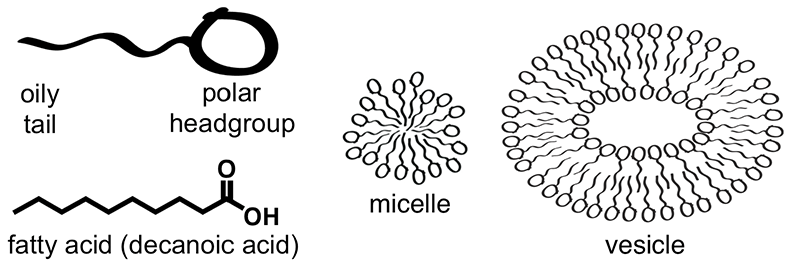Creative Biolabs is one of the well-recognized experts professional in applying advanced drug delivery technologies for a broad range of project objectives. With years of experience, our scientists offer a variety of high-quality lipid-based drug delivery (LDD) systems and custom services to meet our clients’ demands precisely. We also offer versatile delivery strategies for your selection.
Fatty acids (FAs) are carboxylic acids with a long aliphatic chain, either saturated or unsaturated. FA vesicles are colloidal suspensions of closed lipid bilayers, which are composed of fatty acids and their ionized species (soap). They are observed in a small region within the fatty acid-soap-water ternary phase diagram above the chain melting temperature (Tm) of the corresponding fatty acid-soap mixture. They always contain two types of amphiphiles, the nonionized neutral form and the ionized form (the negatively charged soap). The ratio of nonionized neutral form and the ionized form is critical for the vesicle stability. Moreover, FA vesicles are formed not only by unsaturated fatty acids such as oleic acid and linoleic acid, but also by saturated fatty acids such as octanoic acid and decanoic acid.
 Fig. 1 Fatty acids self-assemble into micelles and into vesicles that resemble cell membrane.1,2
Fig. 1 Fatty acids self-assemble into micelles and into vesicles that resemble cell membrane.1,2
Vesicles composed of FAs such as oleic acid and linoleic acid represent new methods for transdermal penetration and localization. Bilayer membrane-bound liposomes or vesicle-compartments composed of amphiphilic lipids have been used as delivery vehicles for drugs, models of cell membranes, and for the development of synthetic cells in many biomedical applications. Liposomes formed by FAs have been proposed by many researchers as potential models of primordial cells due to their high permeability and dynamic properties. In particular, FA liposomes enhance dynamic properties due to the relatively high solubility of single-chain amphiphiles. Similarly, liposomes containing free FA are more sensitive to salts and divalent cations due to the strong interaction between the carboxylic acid head group and the metal ion. In addition, FAs are also used in ufasome. The membrane of ufasome is stabilized by the combination of hydrogen bonding with water in the head, complex formation between ionized and neutral acid molecules, and hydration of dissociated carboxyl groups. The hydrocarbon zone of the FAs is held together by exactly the same dispersion and hydrophobic interactions that stabilize the inner regions of the micelles and membranes.
In fact, vesicles have the bilayer structure of biological membranes and actually they have been proposed as possible precellular systems. Fatty acids have been the material for primordial cell wall which plays an interesting role in vesicles for drug delivery. Empowered with an experienced scientific team and cutting-edge technologies in drug delivery, Creative Biolabs now proudly introduces professional LDD services via its LDD platform to the global clients. In addition to the formulation composed of fatty acids, we offer other customized formulations to satisfy each demand from our customers. Please feel free to contact us for a detailed quote.
References
 For Research Use Only. Not For Clinical Use
For Research Use Only. Not For Clinical UseSupports
Online Inquiry

